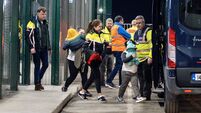Learning from roadkill
Sadly it is quite an efficient way of estimating wildlife populations in an area. The other day I found a beautiful, long-legged fox cub dead on the verge. I estimated it was about three months old so it must have been born quite early in the year.
Monitoring roadkill can yield interesting results. I live in Co Kildare and about 20 years ago the first evidence that pine martins had returned after a long absence was provided by one that had been hit by a car.
The driver delivered the corpse to the local wildlife ranger for identification. Another driver arrived with a rather smelly corpse in the boot of his car which yielded the interesting information that there was a population of feral ferrets in the area. I have also been able to use roadkill to monitor the decline of grey squirrels around my home and the subsequent increase in the number of red squirrels.
I did a bit of internet research and discovered that internationally, the subject is taken quite seriously and there is a lot of academic literature.
A researcher in the Netherlands became interested in the idea that roadkill might be a factor in the declining number of winged insects. He analysed insect bodies on car licence plates and discovered an average of two dead insects per 10km driven. When he extrapolated this finding he came up with the rather extraordinary result that in the Netherlands 1.6 trillion insects are killed by cars every year.
Collisions with large animals such as deer, or even with large birds, can be damaging to both parties in the accident. I once collided with a fallow deer that jumped over a hedge at night. I had to call out a vet to have the animal put down and there was a lot of damage done to the car. Incidents like this have even caused driver fatalities. Motorways that traverse countryside with large populations of deer are often protected by special deer fencing.
But there is evidence that some birds, and probably some carnivorous animals, have learned to exploit the growth in the death toll of wildlife on our roads.
Magpies and hooded crows have been observed flying along roads early in the morning searching for overnight fatalities that will provide them with breakfast. Another bird that eats a lot of carrion is the red kite and there is an ongoing project to reintroduce Welsh birds to Co Wicklow and Co Dublin. One of the introduced birds was killed by a train and it’s believed that at the time it was feeding on a corpse that had been killed by an earlier train — but I suppose that’s rail kill rather than road kill.














